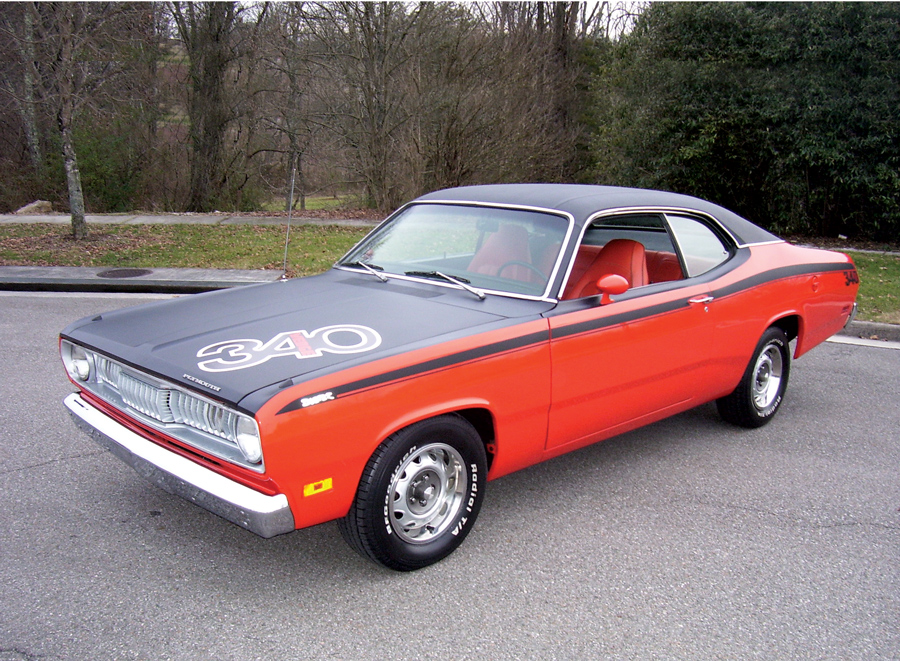- Fresh 340-ci 4-bbl engine
- 727 automatic transmission
- Factory a/c car
- Broadcast sheet
- New T/A radials
- New paint
- Factory EV2 Tor-Red (Hemi Orange)
- V24 Performance Hood Treatment with engine callout
SCM Analysis
Detailing
| Vehicle: | 1971 Plymouth Duster 340 |
| Years Produced: | 1970–73 |
| Number Produced: | 24,817 (1970 340 cars) |
| SCM Valuation: | $22,470 |
| Tune Up Cost: | $200 |
| Chassis Number Location: | Plate at base of windshield |
| Engine Number Location: | Left side of block |
| Alternatives: | 1967–76 Dodge Dart, 1965–73 Ford Mustang, 1967–73 Chevrolet Camaro |
| Investment Grade: | C |
This car, Lot FR0140, sold for $29,700, including buyer’s premium, at the GAA Classic Cars auction in Greensboro, NC, on February 28, 2020.
In every family, there’s a kid who always seems to get overshadowed by his siblings. It’s not that there’s anything wrong with the kid, but the older brother just gets all the attention. In the Mopar family, the Duster is that overlooked child.
Compared to the GTX, Barracuda, Road Runner and Superbird, or to the Dodge Coronet, Challenger and Charger lineup, the baby-brother Duster just never got much glory.
Valiant beginnings
The Plymouth Duster was introduced for the 1970 model year as a sportier 2-door fastback version of the workhorse Valiant compact sedan. The basic Duster came equipped with the venerable slant-6 engine in 198- or 225-cubic-inch displacement, but buyers could also upgrade to the 318 or 340 V8 engines.
The Duster 340 was the hot rod of the bunch. A Carter 4-barrel carburetor yielded an official rating of 275 horsepower and 340 foot-pounds of torque. Buyers could choose the standard 3-speed manual transmission or upgrade to a 4-speed or a TorqueFlite automatic. Out back, 3.23 gears were standard, but limited-slip 3.55 or 3.91 final-drive gears were available. The Duster 340 also got a few extra goodies not available on the more-economical trim levels, such as beefier springs, bigger sway bars and Rally wheels.
Options included the very desirable pistol-grip shift knob, bucket seats, floor-mount shifter and a tach. Suggested base retail price on a 1970 Duster 340 was $2,547. The formula was reasonably successful, and Plymouth sold 24,817 Duster 340s that year, among more than 200,000 Dusters sold overall.
However, the Duster hit the showrooms at the same moment the Barracuda graduated away from its early Valiant underpinnings and got its own E-body classification. The new ’Cuda offered stunning looks and 425 horsepower if you bought the 426 Hemi. Plymouth also released the Road Runner Superbird that year, so it was hard for the Duster to stand out in the Plymouth family.
The Duster you want
If you’re looking for your first Mopar, or if you just don’t have a Duster to complete your collection, this one would have been a solid choice. After the first year, sales of the Duster 340 dropped to 12,886 in 1971. In 1972, The Duster 340’s horsepower dropped to 240, but sales rose to 15,681, and we all know how it went in the years that followed. The Duster 340 that you want was made in 1970 or 1971 and was originally ordered with all the good stuff.
What’s impressive is that you can take your pick of nice Dusters, and the price you’ll pay is generally reasonable.
This attractively restored Duster 340 sold for $29,700, and that’s right in the fat part of the bell curve for a Duster of this quality. The orange-over-black color scheme inside and out gives this car the appropriate in-your-face quality that Mopar owners prize, and the car comes with its original “production broadcast” build sheet to document its authenticity.
To prove the point about affordability, there were two other Dusters sold at the same GAA Classic Cars auction in February. Lot FR0055 was a 1972 Duster built up as a replica Duster 340 that sold for $24,300, and Lot FR0023 was a well-kept ’73 model that sold for $22,680. Looking through the ACC Premium Auction Database, that’s typical. While a few 1970 models have peaked as high as $48,400 (ACC# 6913604), the vast majority are changing hands under the price of this example.
Sign of the times?
One final note: At least at this auction, muscle-car prices were generally lagging. There were many 1970s pickup trucks selling at the same price range as this Duster. However, a nice resto-mod 1972 Barracuda with a 440 (Lot FR006) sold for $41,580, which is almost $10k above the ACC Pocket Price Guide median valuation for the model.
What does this tell us? Certainly it says that some buyers took home some great deals on Mopar muscle. But more broadly, it seems that the market for resto-mod, replica and even well-restored muscle cars that are not particularly rare may be becoming more selective.
My feeling is that there will always be a market for these run-of-the-factory cars, precisely because they are not rare or expensive.
A muscle car you can drive and enjoy without considering it part of your retirement portfolio is a good thing to have — especially if you find one with all the right options, like this example. Mopar’s overlooked kid can pitch a no-hitter, too.
(Introductory description courtesy of GAA Classic Cars.)
